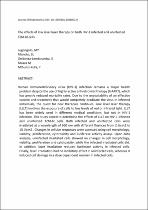 ResearchSpace
ResearchSpace
The effects of low level laser therapy on both HIV-1 infected and uninfected TZM-bl cells
JavaScript is disabled for your browser. Some features of this site may not work without it.
- ResearchSpace
- →
- Research Publications/Outputs
- →
- Journal Articles
- →
- View Item
| dc.contributor.author |
Lugongolo, Masixole Y

|
|
| dc.contributor.author |
Manoto, Sello L

|
|
| dc.contributor.author |
Ombinda-Lemboumba, Saturnin

|
|
| dc.contributor.author |
Maaza, M

|
|
| dc.contributor.author |
Mthunzi-Kufa, Patience

|
|
| dc.date.accessioned | 2017-09-13T10:43:46Z | |
| dc.date.available | 2017-09-13T10:43:46Z | |
| dc.date.issued | 2017-01 | |
| dc.identifier.citation | Lugongolo, M.Y., Manoto, S.L., Ombinda-Lemboumba, S. et al. 2017. The effects of low level laser therapy on both HIV-1 infected and uninfected TZM-bl cells. Journal of Biophotonics, DOI: 10.1002/jbio.201600217 | en_US |
| dc.identifier.issn | 1864-063X | |
| dc.identifier.uri | DOI: 10.1002/jbio.201600217 | |
| dc.identifier.uri | http://onlinelibrary.wiley.com/doi/10.1002/jbio.201600217/full | |
| dc.identifier.uri | http://hdl.handle.net/10204/9552 | |
| dc.description | Copyright: 2017 Wiley. Due to copyright restrictions, the attached PDF file only contains the abstract of the full text item. For access to the full text item, kindly consult the publisher's website. | en_US |
| dc.description.abstract | Human immunodeficiency virus (HIV-1) infection remains a major health problem despite the use of highly active antiretroviral therapy (HAART), which has greatly reduced mortality rates. Due to the unavailability of an effective vaccine and treatment that would completely eradicate the virus in infected individuals, the quest for new therapies continues. Low level laser therapy (LLLT) involves the exposure of cells to low levels of red or infrared light. LLLT has been widely used in different medical conditions, but not in HIV-1 infection. This study aimed to determine the effects of LLLT on HIV-1 infected and uninfected TZM-bl cells. Both infected and uninfected cells were irradiated at a wavelength of 660 nm with different fluences from 2 J/cm2 to 10 J/cm2 . Changes in cellular responses were assessed using cell morphology, viability, proliferation, cytotoxicity and luciferase activity assays. Upon data analysis, uninfected irradiated cells showed no changes in cell morphology, viability, proliferation and cytotoxicity, while the infected irradiated cells did. In addition, laser irradiation reduced luciferase activity in infected cells. Finally, laser irradiation had no inhibitory effect in uninfected cells, whereas it induced cell damage in a dose dependent manner in infected cells. | en_US |
| dc.language.iso | en | en_US |
| dc.publisher | Wiley | en_US |
| dc.relation.ispartofseries | Worklist;18528 | |
| dc.subject | Low level laser therapy | en_US |
| dc.subject | HIV-1 | en_US |
| dc.subject | TZM-bl cells | en_US |
| dc.subject | Infected | en_US |
| dc.subject | Uninfected | en_US |
| dc.subject | Fluences | en_US |
| dc.title | The effects of low level laser therapy on both HIV-1 infected and uninfected TZM-bl cells | en_US |
| dc.type | Article | en_US |
| dc.identifier.apacitation | Lugongolo, M. Y., Manoto, S. L., Ombinda-Lemboumba, S., Maaza, M., & Mthunzi-Kufa, P. (2017). The effects of low level laser therapy on both HIV-1 infected and uninfected TZM-bl cells. http://hdl.handle.net/10204/9552 | en_ZA |
| dc.identifier.chicagocitation | Lugongolo, Masixole Y, Sello L Manoto, Saturnin Ombinda-Lemboumba, M Maaza, and Patience Mthunzi-Kufa "The effects of low level laser therapy on both HIV-1 infected and uninfected TZM-bl cells." (2017) http://hdl.handle.net/10204/9552 | en_ZA |
| dc.identifier.vancouvercitation | Lugongolo MY, Manoto SL, Ombinda-Lemboumba S, Maaza M, Mthunzi-Kufa P. The effects of low level laser therapy on both HIV-1 infected and uninfected TZM-bl cells. 2017; http://hdl.handle.net/10204/9552. | en_ZA |
| dc.identifier.ris | TY - Article AU - Lugongolo, Masixole Y AU - Manoto, Sello L AU - Ombinda-Lemboumba, Saturnin AU - Maaza, M AU - Mthunzi-Kufa, Patience AB - Human immunodeficiency virus (HIV-1) infection remains a major health problem despite the use of highly active antiretroviral therapy (HAART), which has greatly reduced mortality rates. Due to the unavailability of an effective vaccine and treatment that would completely eradicate the virus in infected individuals, the quest for new therapies continues. Low level laser therapy (LLLT) involves the exposure of cells to low levels of red or infrared light. LLLT has been widely used in different medical conditions, but not in HIV-1 infection. This study aimed to determine the effects of LLLT on HIV-1 infected and uninfected TZM-bl cells. Both infected and uninfected cells were irradiated at a wavelength of 660 nm with different fluences from 2 J/cm2 to 10 J/cm2 . Changes in cellular responses were assessed using cell morphology, viability, proliferation, cytotoxicity and luciferase activity assays. Upon data analysis, uninfected irradiated cells showed no changes in cell morphology, viability, proliferation and cytotoxicity, while the infected irradiated cells did. In addition, laser irradiation reduced luciferase activity in infected cells. Finally, laser irradiation had no inhibitory effect in uninfected cells, whereas it induced cell damage in a dose dependent manner in infected cells. DA - 2017-01 DB - ResearchSpace DP - CSIR KW - Low level laser therapy KW - HIV-1 KW - TZM-bl cells KW - Infected KW - Uninfected KW - Fluences LK - https://researchspace.csir.co.za PY - 2017 SM - 1864-063X T1 - The effects of low level laser therapy on both HIV-1 infected and uninfected TZM-bl cells TI - The effects of low level laser therapy on both HIV-1 infected and uninfected TZM-bl cells UR - http://hdl.handle.net/10204/9552 ER - | en_ZA |





